Tyler Derr
Towards Trustworthy Retrieval Augmented Generation for Large Language Models: A Survey
Feb 08, 2025Abstract:Retrieval-Augmented Generation (RAG) is an advanced technique designed to address the challenges of Artificial Intelligence-Generated Content (AIGC). By integrating context retrieval into content generation, RAG provides reliable and up-to-date external knowledge, reduces hallucinations, and ensures relevant context across a wide range of tasks. However, despite RAG's success and potential, recent studies have shown that the RAG paradigm also introduces new risks, including robustness issues, privacy concerns, adversarial attacks, and accountability issues. Addressing these risks is critical for future applications of RAG systems, as they directly impact their trustworthiness. Although various methods have been developed to improve the trustworthiness of RAG methods, there is a lack of a unified perspective and framework for research in this topic. Thus, in this paper, we aim to address this gap by providing a comprehensive roadmap for developing trustworthy RAG systems. We place our discussion around five key perspectives: reliability, privacy, safety, fairness, explainability, and accountability. For each perspective, we present a general framework and taxonomy, offering a structured approach to understanding the current challenges, evaluating existing solutions, and identifying promising future research directions. To encourage broader adoption and innovation, we also highlight the downstream applications where trustworthy RAG systems have a significant impact.
WelQrate: Defining the Gold Standard in Small Molecule Drug Discovery Benchmarking
Nov 14, 2024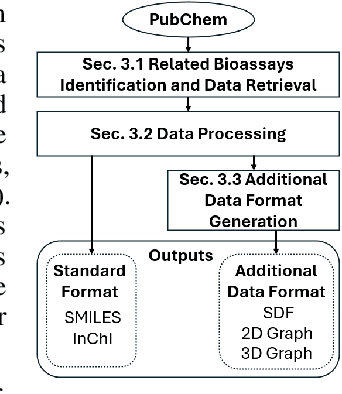
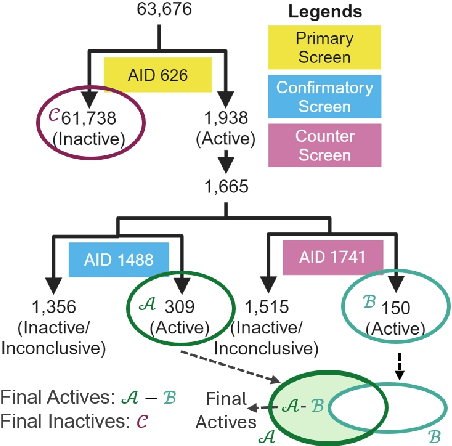

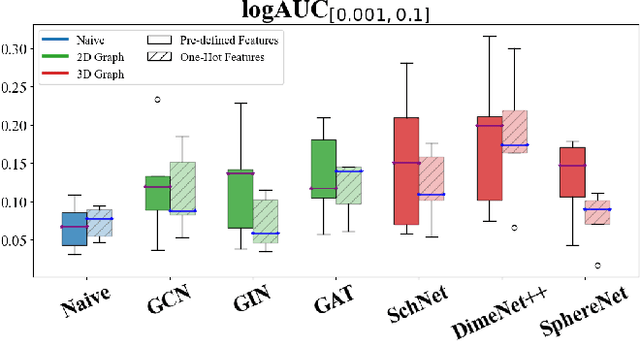
Abstract:While deep learning has revolutionized computer-aided drug discovery, the AI community has predominantly focused on model innovation and placed less emphasis on establishing best benchmarking practices. We posit that without a sound model evaluation framework, the AI community's efforts cannot reach their full potential, thereby slowing the progress and transfer of innovation into real-world drug discovery. Thus, in this paper, we seek to establish a new gold standard for small molecule drug discovery benchmarking, WelQrate. Specifically, our contributions are threefold: WelQrate Dataset Collection - we introduce a meticulously curated collection of 9 datasets spanning 5 therapeutic target classes. Our hierarchical curation pipelines, designed by drug discovery experts, go beyond the primary high-throughput screen by leveraging additional confirmatory and counter screens along with rigorous domain-driven preprocessing, such as Pan-Assay Interference Compounds (PAINS) filtering, to ensure the high-quality data in the datasets; WelQrate Evaluation Framework - we propose a standardized model evaluation framework considering high-quality datasets, featurization, 3D conformation generation, evaluation metrics, and data splits, which provides a reliable benchmarking for drug discovery experts conducting real-world virtual screening; Benchmarking - we evaluate model performance through various research questions using the WelQrate dataset collection, exploring the effects of different models, dataset quality, featurization methods, and data splitting strategies on the results. In summary, we recommend adopting our proposed WelQrate as the gold standard in small molecule drug discovery benchmarking. The WelQrate dataset collection, along with the curation codes, and experimental scripts are all publicly available at WelQrate.org.
Personalization of Large Language Models: A Survey
Oct 29, 2024Abstract:Personalization of Large Language Models (LLMs) has recently become increasingly important with a wide range of applications. Despite the importance and recent progress, most existing works on personalized LLMs have focused either entirely on (a) personalized text generation or (b) leveraging LLMs for personalization-related downstream applications, such as recommendation systems. In this work, we bridge the gap between these two separate main directions for the first time by introducing a taxonomy for personalized LLM usage and summarizing the key differences and challenges. We provide a formalization of the foundations of personalized LLMs that consolidates and expands notions of personalization of LLMs, defining and discussing novel facets of personalization, usage, and desiderata of personalized LLMs. We then unify the literature across these diverse fields and usage scenarios by proposing systematic taxonomies for the granularity of personalization, personalization techniques, datasets, evaluation methods, and applications of personalized LLMs. Finally, we highlight challenges and important open problems that remain to be addressed. By unifying and surveying recent research using the proposed taxonomies, we aim to provide a clear guide to the existing literature and different facets of personalization in LLMs, empowering both researchers and practitioners.
Large Language Model-based Augmentation for Imbalanced Node Classification on Text-Attributed Graphs
Oct 22, 2024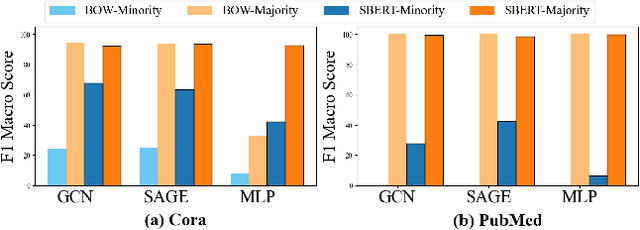
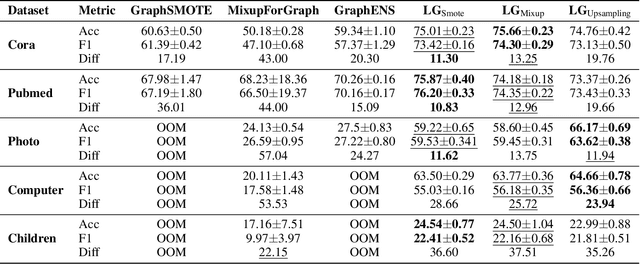

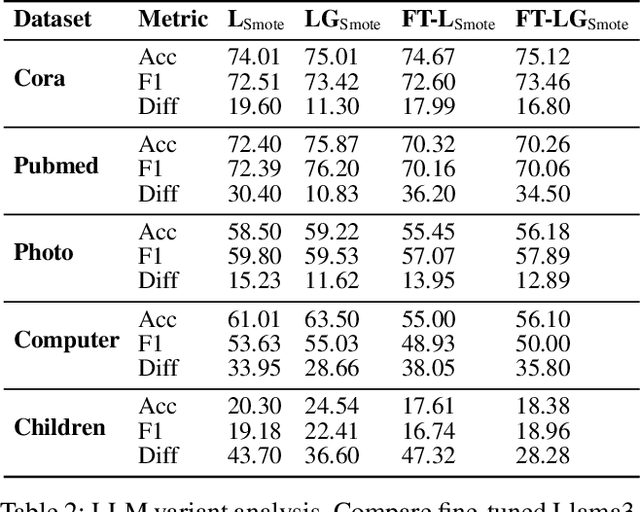
Abstract:Node classification on graphs frequently encounters the challenge of class imbalance, leading to biased performance and posing significant risks in real-world applications. Although several data-centric solutions have been proposed, none of them focus on Text-Attributed Graphs (TAGs), and therefore overlook the potential of leveraging the rich semantics encoded in textual features for boosting the classification of minority nodes. Given this crucial gap, we investigate the possibility of augmenting graph data in the text space, leveraging the textual generation power of Large Language Models (LLMs) to handle imbalanced node classification on TAGs. Specifically, we propose a novel approach called LA-TAG (LLM-based Augmentation on Text-Attributed Graphs), which prompts LLMs to generate synthetic texts based on existing node texts in the graph. Furthermore, to integrate these synthetic text-attributed nodes into the graph, we introduce a text-based link predictor to connect the synthesized nodes with the existing nodes. Our experiments across multiple datasets and evaluation metrics show that our framework significantly outperforms traditional non-textual-based data augmentation strategies and specific node imbalance solutions. This highlights the promise of using LLMs to resolve imbalance issues on TAGs.
Towards Trustworthy Knowledge Graph Reasoning: An Uncertainty Aware Perspective
Oct 11, 2024Abstract:Recently, Knowledge Graphs (KGs) have been successfully coupled with Large Language Models (LLMs) to mitigate their hallucinations and enhance their reasoning capability, such as in KG-based retrieval-augmented frameworks. However, current KG-LLM frameworks lack rigorous uncertainty estimation, limiting their reliable deployment in high-stakes applications. Directly incorporating uncertainty quantification into KG-LLM frameworks presents challenges due to their complex architectures and the intricate interactions between the knowledge graph and language model components. To address this gap, we propose a new trustworthy KG-LLM framework, Uncertainty Aware Knowledge-Graph Reasoning (UAG), which incorporates uncertainty quantification into the KG-LLM framework. We design an uncertainty-aware multi-step reasoning framework that leverages conformal prediction to provide a theoretical guarantee on the prediction set. To manage the error rate of the multi-step process, we additionally introduce an error rate control module to adjust the error rate within the individual components. Extensive experiments show that our proposed UAG can achieve any pre-defined coverage rate while reducing the prediction set/interval size by 40% on average over the baselines.
A Survey of Mamba
Aug 02, 2024Abstract:Deep learning, as a vital technique, has sparked a notable revolution in artificial intelligence. As the most representative architecture, Transformers have empowered numerous advanced models, especially the large language models that comprise billions of parameters, becoming a cornerstone in deep learning. Despite the impressive achievements, Transformers still face inherent limitations, particularly the time-consuming inference resulting from the quadratic computation complexity of attention calculation. Recently, a novel architecture named Mamba, drawing inspiration from classical state space models, has emerged as a promising alternative for building foundation models, delivering comparable modeling abilities to Transformers while preserving near-linear scalability concerning sequence length. This has sparked an increasing number of studies actively exploring Mamba's potential to achieve impressive performance across diverse domains. Given such rapid evolution, there is a critical need for a systematic review that consolidates existing Mamba-empowered models, offering a comprehensive understanding of this emerging model architecture. In this survey, we therefore conduct an in-depth investigation of recent Mamba-associated studies, covering from three main aspects: the advancements of Mamba-based models, the techniques of adapting Mamba to diverse data, and the applications where Mamba can excel. Specifically, we first recall the foundational knowledge of various representative deep learning models and the details of Mamba as preliminaries. Then, to showcase the significance of Mamba, we comprehensively review the related studies focusing on Mamba models' architecture design, data adaptability, and applications. Finally, we present an discussion of current limitations and explore various promising research directions to provide deeper insights for future investigations.
FT-AED: Benchmark Dataset for Early Freeway Traffic Anomalous Event Detection
Jun 24, 2024Abstract:Early and accurate detection of anomalous events on the freeway, such as accidents, can improve emergency response and clearance. However, existing delays and errors in event identification and reporting make it a difficult problem to solve. Current large-scale freeway traffic datasets are not designed for anomaly detection and ignore these challenges. In this paper, we introduce the first large-scale lane-level freeway traffic dataset for anomaly detection. Our dataset consists of a month of weekday radar detection sensor data collected in 4 lanes along an 18-mile stretch of Interstate 24 heading toward Nashville, TN, comprising over 3.7 million sensor measurements. We also collect official crash reports from the Nashville Traffic Management Center and manually label all other potential anomalies in the dataset. To show the potential for our dataset to be used in future machine learning and traffic research, we benchmark numerous deep learning anomaly detection models on our dataset. We find that unsupervised graph neural network autoencoders are a promising solution for this problem and that ignoring spatial relationships leads to decreased performance. We demonstrate that our methods can reduce reporting delays by over 10 minutes on average while detecting 75% of crashes. Our dataset and all preprocessing code needed to get started are publicly released at https://vu.edu/ft-aed/ to facilitate future research.
Edge Classification on Graphs: New Directions in Topological Imbalance
Jun 18, 2024Abstract:Recent years have witnessed the remarkable success of applying Graph machine learning (GML) to node/graph classification and link prediction. However, edge classification task that enjoys numerous real-world applications such as social network analysis and cybersecurity, has not seen significant advancement. To address this gap, our study pioneers a comprehensive approach to edge classification. We identify a novel `Topological Imbalance Issue', which arises from the skewed distribution of edges across different classes, affecting the local subgraph of each edge and harming the performance of edge classifications. Inspired by the recent studies in node classification that the performance discrepancy exists with varying local structural patterns, we aim to investigate if the performance discrepancy in topological imbalanced edge classification can also be mitigated by characterizing the local class distribution variance. To overcome this challenge, we introduce Topological Entropy (TE), a novel topological-based metric that measures the topological imbalance for each edge. Our empirical studies confirm that TE effectively measures local class distribution variance, and indicate that prioritizing edges with high TE values can help address the issue of topological imbalance. Based on this, we develop two strategies - Topological Reweighting and TE Wedge-based Mixup - to focus training on (synthetic) edges based on their TEs. While topological reweighting directly manipulates training edge weights according to TE, our wedge-based mixup interpolates synthetic edges between high TE wedges. Ultimately, we integrate these strategies into a novel topological imbalance strategy for edge classification: TopoEdge. Through extensive experiments, we demonstrate the efficacy of our proposed strategies on newly curated datasets and thus establish a new benchmark for (imbalanced) edge classification.
Large Generative Graph Models
Jun 07, 2024Abstract:Large Generative Models (LGMs) such as GPT, Stable Diffusion, Sora, and Suno are trained on a huge amount of language corpus, images, videos, and audio that are extremely diverse from numerous domains. This training paradigm over diverse well-curated data lies at the heart of generating creative and sensible content. However, all previous graph generative models (e.g., GraphRNN, MDVAE, MoFlow, GDSS, and DiGress) have been trained only on one dataset each time, which cannot replicate the revolutionary success achieved by LGMs in other fields. To remedy this crucial gap, we propose a new class of graph generative model called Large Graph Generative Model (LGGM) that is trained on a large corpus of graphs (over 5000 graphs) from 13 different domains. We empirically demonstrate that the pre-trained LGGM has superior zero-shot generative capability to existing graph generative models. Furthermore, our pre-trained LGGM can be easily fine-tuned with graphs from target domains and demonstrate even better performance than those directly trained from scratch, behaving as a solid starting point for real-world customization. Inspired by Stable Diffusion, we further equip LGGM with the capability to generate graphs given text prompts (Text-to-Graph), such as the description of the network name and domain (i.e., "The power-1138-bus graph represents a network of buses in a power distribution system."), and network statistics (i.e., "The graph has a low average degree, suitable for modeling social media interactions."). This Text-to-Graph capability integrates the extensive world knowledge in the underlying language model, offering users fine-grained control of the generated graphs. We release the code, the model checkpoint, and the datasets at https://lggm-lg.github.io/.
Augmenting Textual Generation via Topology Aware Retrieval
May 27, 2024Abstract:Despite the impressive advancements of Large Language Models (LLMs) in generating text, they are often limited by the knowledge contained in the input and prone to producing inaccurate or hallucinated content. To tackle these issues, Retrieval-augmented Generation (RAG) is employed as an effective strategy to enhance the available knowledge base and anchor the responses in reality by pulling additional texts from external databases. In real-world applications, texts are often linked through entities within a graph, such as citations in academic papers or comments in social networks. This paper exploits these topological relationships to guide the retrieval process in RAG. Specifically, we explore two kinds of topological connections: proximity-based, focusing on closely connected nodes, and role-based, which looks at nodes sharing similar subgraph structures. Our empirical research confirms their relevance to text relationships, leading us to develop a Topology-aware Retrieval-augmented Generation framework. This framework includes a retrieval module that selects texts based on their topological relationships and an aggregation module that integrates these texts into prompts to stimulate LLMs for text generation. We have curated established text-attributed networks and conducted comprehensive experiments to validate the effectiveness of this framework, demonstrating its potential to enhance RAG with topological awareness.
 Add to Chrome
Add to Chrome Add to Firefox
Add to Firefox Add to Edge
Add to Edge